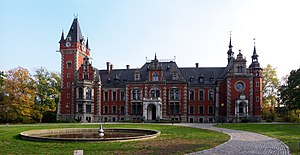Plawniowitz Castle
The Plawniowitz Castle was the ancestral home of the family Ballestrem in the Polish village of Pławniowice northwest of Gliwice (Gleiwitz). It is a building in the historicist neo-renaissance style from the 19th century made of red bricks with decorative plaster .
history
In 1798 the Plawniowitz estate was taken over by Count Carl Franz von Ballestrem .
The castle was built between 1882 and 1885. The builder was Count Franz von Ballestrem , the builder was Konstantin Heidenreich from Koppitz. A previous building from 1737 stood on the site of the new castle.
The last German owner was Nikolaus Graf von Ballestrem . He had to leave the castle in the spring of 1945 before the approaching Red Army . Under the Polish administration from 1945 onwards, the Ballestrems' property was confiscated and nationalized. The Polish state then handed the castle over to the Catholic Church .
In the 1990s, the palace and park complex was restored with funds from the German Federal Ministry of the Interior and expanded into a conference venue for the Diocese of Opole . Today it belongs to the Diocese of Gliwice.
architecture
Main castle
The historicist brick building was built in the neo-renaissance style. The castle has two side wings. It has a large rectangular tower on the outside of the north wing, a smaller round tower on the chapel in the south wing and other small round towers on the inside.
Outbuildings
The palace complex includes a gentleman's house , a library and an estate. A granary from 1888 is located on the estate. A chapel is integrated on the south side of the castle.
Park
The castle park extends to the west and mostly to the east of the castle. In the western part there is a fountain, in the eastern part the monument to Count Giovanni Battista Angelo Ballestrem ( Ballestrero ) di Castellengo, a pond and a photo documentation of the restoration.
Monument to Johann von Ballestrem
The granite and marble monument to Johann Angelus von Ballestrem (Giovanni Battista Angelo Ballestrem) was inaugurated in September 1907 and is located in the park at the rear of the castle. The count married Auguste Elisabeth von Stechow on Plawniowitz-Ruda. Since the Stechow family died out in the male line in 1799, his son inherited the Majorate Plawniowitz-Ruda-Biskupitz, and the von Ballestrem family thus settled permanently on Plawniowitz.
The memorial is a work by the Berlin sculptor Josef Limburg . A painting by Johann von Ballestrem, which was in Plawniowitz Castle, served as a template for the bust. The bust Ballestrem adorns a Attila and a fur. The memorial was donated by Johann von Ballestrem's grandson Franz .
Before Limburg created the bust for Johann von Ballestrem, he made a marble bust of Franz von Ballestrem. He became aware of Limburg at the Great Berlin Art Exhibition when he saw his bust of Pope Pius X from 1904. He then invited him in 1905 to do modeling at Plawniowitz Castle.
After 1945 the monument was destroyed. Since the head, one arm and one hand of the bust were chopped off, they had to be recreated during the restoration of the park in the 1990s. The inscriptions on the base have been knocked out to this day.
literature
- Konrad Fries: The rebuilt Plawniowitz Castle in Silesia. In: ARX. Castles and palaces in Bavaria, Austria and South Tyrol. Vol. 38, No. 1, 2016, ISSN 0394-0624 , pp. 57-61.
Web links
- Castle website (Polish, German, English)
Individual evidence
- ↑ a b c History of the castle and its park on plawniowice.pl , accessed on October 17, 2016.
- ^ Journal of Upper Silesia, Volume 7, Issue 5 , 1908.
- ↑ Upper Silesia in Pictures, year 1927, issue No. 26
- ↑ Photo documentation of the park restoration
Coordinates: 50 ° 22 ′ 55.3 " N , 18 ° 28 ′ 34.1" E


